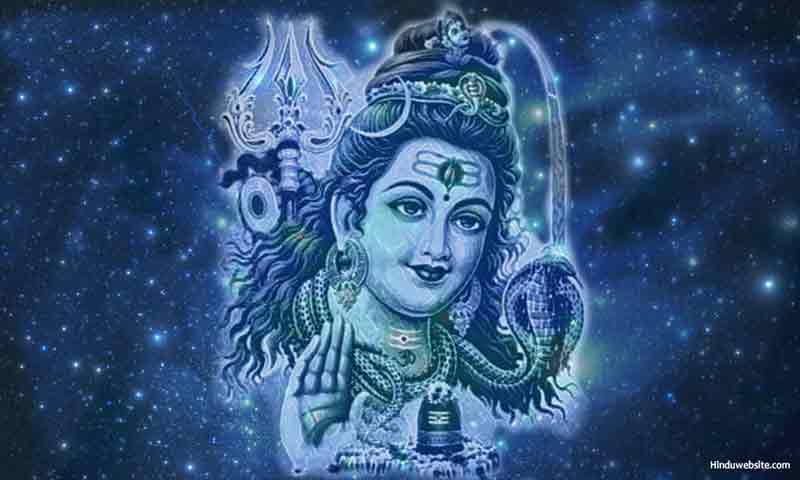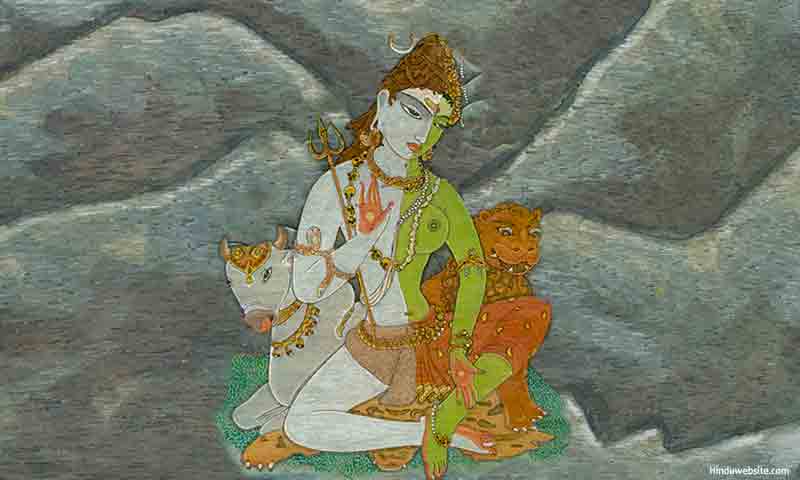
Lord Shiva as Isvara, the Manifested Brahman

Shiva Lingam is the subtle body of Shiva as Isvara with Shakti as his dynamic force.
In Shaivism Lord Shiva is worshipped as Brahman himself. In his manifested aspect (vyakta) he becomes Isvara, the lord of the universe and the whole creation. Isvara is his dynamic form, with awakened Shakti, who acts as the creator, preserver, concealer, revealer and destroyer of all manifested things. We are not going to debate here whether Shiva and Shakti are separate and represent the dual realities of existence or just one.
Shiva and Shakti
For the purpose of this discussion, we hold the nondualistic view of existence and accept Shiva as the only reality, and everything else as his projection. By Shiva we mean both Shiva and Shakti. In their purest aspect, Shiva and Shakti are inseparable and indistinguishable. It is the same in both the macrocosm of creation and the microcosm of your own being.
Your very existence arises from Shiva and Shakti, and you very much represent the union between them. Shakti is your perceptible and cognizable aspect. Shiva is your hidden aspect, your very Self. Until you become pure and transcend the duality, you remain a deluded Shiva. You will be equated in Shaivism with pasu (ignorant being) rather than with Pati (the lord in control of his dynamic force).
 Ardhanariswara, the iconic representation of the inseparable union
between Shiva and Shakti. © S. RAJAM, KAUAI'S HINDU MONASTERY.
Ardhanariswara, the iconic representation of the inseparable union
between Shiva and Shakti. © S. RAJAM, KAUAI'S HINDU MONASTERY.
Please read the following statements carefully. They are difficult to grasp unless you pay attention. Shiv (शिव) means pure and auspicious. Shiva (शिवा) means of or pertaining to Parvathi or Shakti. Thus, Shiva (the god) is the manifested Shiv (Pure and auspicious Brahman), endowed with Shakti (the goddess) or vice versa. In Shakti, Shiv resides as her essential nature. In Shiva, Shakti resides as his essential force. Hence, when we say, "Shiva," we are literally referring to both the god and the goddess, representing one inseparable reality.
Shiv is the unmanifested (avyakta), unformed (nirguna) Brahman, in whom Prakriti (or Shakti) remains dormant. In this state, the triple gunas (sattva, rajas and tamas), which are responsible for all movements and actions, remain latent in her in a state of equilibrium. Hence, she is known as Adi Shakti, Mula Prakriti or Primal Nature. As the manifested Brahman, in whom Shakti awakens and becomes active, Shiva attains forms and qualities. In this state, Shiva devolves from Supreme Self to Supreme Being or Isvara, the Lord of the Universe. In Shakti, the equilibrium of the gunas becomes disturbed, whereby she becomes the universal, dynamic and transformative force, and the source of all actions under the will of Shiva.
Thus, Shiva is the manifested Brahman, the Being or Purusha (person) with qualities and attributes. He acts as Isvara, the Lord of the universe in the field (kshetra) of Nature. He has no gender because he represents both the male and female aspects of creation. The scriptures extol him as half male and half female (ardha nariswara).
As the supreme being who is in union with Shakti, Shiva represents all the dualities and diversity of creation. The duality of Shiv and Shakti are inherent in him, with Shiv as the witnessing Self, and Shakti as his dynamic and inseparable force. Shiv is Purusha, the Cosmic Being. Shakti is Prakriti, Mother Nature. They are also known as kshetrajna (owner of the field) and Kshetra (the field) respectively, the field being the material universe or creation itself.
In living beings, Shiva remains the witness consciousness, taking no part in their existence other than letting Shakti execute her play with the help of the Tattvas (realities), subjecting them to delusion, ignorance, desire, attachments, suffering, rebirth and bondage. In this state, although Shiv and Shakti are in the same field, they remain separate and distinct. The Kundalini Shakti remains dormant in the lowest chakra as a coiled serpent. In the awakened beings she rises to the top and joins Shiv, the auspicious in the Sahasrara.
In the beings, Shiva also represents Aham or the individuality or self-awareness (the ego) as his reflection in the field of Nature. The nature of the reflection (or ego) depends upon the nature of the field (ksehtra or body). If it is is filled with sattva, the ego will have the nature of Sattva. If it is filled with rajas, it will have the nature of rajas, and so on. As the first letter in the alphabet, "A" represents Shiva, the Self. "Ha" represents the sound of prana (breath), energy or Shakti. "Aham" means the reality (tattva) which represents the union of Shiv and Shakti in the material field. In a liberated being they shine in their own light. In deluded beings, they remained covered up by several impurities. When the impurities are removed, Aham becomes absorbed in pure consciousness. Thus, the word Shiva not only refers to God but also to the pure state of a liberated being in whom Kundalini Shakti is fully awakened and Shiv and Shakti are in perfect union. A self-realized Yogi or Sadhu or Siddha is but Shiva only in human form. Others are Shiva in the making.
 A devotee of Shiva in worship. Partial reproduction. © S. RAJAM,
KAUAI'S HINDU MONASTERY
A devotee of Shiva in worship. Partial reproduction. © S. RAJAM,
KAUAI'S HINDU MONASTERY
The worship of Shiva
In mainstream Hinduism, Shiva is worshipped both ritually and devotionally in temples and at homes. Devotees follow various methods and approaches to worship Shiva according to the sect or the teacher tradition they follow. They can broadly be classified into right-hand (parsvachara) and left-hand (vamachara) methods. According to Kularnava and Jnanadipa Tantras, as quoted by Sir John Woodroffe in his book Shakta and Shakti, right-hand methods of worship include four traditional and conventional schools namely Vedachara, Vaishnavachara, Shaivachara and Dakshinachara. They serve an important role as foundational practices which prepare the seeker in self-purification and help them progress on the path. The left-hand methods follow three unconventional and esoteric schools namely Vama, Siddhanta and Kaula. The last one is considered the highest in the Tantra tradition. They are meant for advanced practitioners who are ripe for liberation.
Although in some sects of Shaivism, the path of service (charya) and devotion (kriya) are considered inferior to the path of knowledge (sanmarga), ritual worship is practiced widely in all sects of Shaivism. Devotees of Shiva ritually worship his anthropomorphic and symbolic forms. They may worship him as images or idols, as Yantras or mystic diagrams, as the Pranava or Aum, as silence (between thoughts), as internal sound (nada), as bijaksharas (primal sounds or letters) and as Shiva Lingam. Aum and bijaksharas are mostly used in chanting and meditative practices. Mystic diagrams are used in Tantric rituals and occult practices, whereas Shiva Lingams are used both for ritual and meditative practices.
Suggestions for Further Reading
- Notes on Shiva Lingam
- Shiva Lingam Symbolic Significance
- Symbolism of Hindu Concepts, Gods and Goddesses
- Symbolism and Significance of Vibhuthi in Hinduism
- The Symbolism of Purusha and Prakriti
- The Symbolism of Mahishasura Mardini
- Ganesha As Mahat Tattva, Supreme Intelligence
- Aspects of Lord Shiva
- Nataraja, The Lord of the Cosmic Dance
- Shiva the Unconventional God of Opposites
- The Panchanana Aspects and Forms of Shiva
- History of Shaivism, Lord Shiva in Vedic Literature and Recorded History
- Significance of Lord Shiva
- Tantra and Tantric Rituals of Hinduism and Buddhism
- Mahanirvana Tantra the Tantra of the Great Liberation Chapter Index
- Sex and Spirituality In the Upanishads
- Concept of Death, Hell and Afterlife in Hinduism
- Goddesses of Hinduism, Their Symbolism and Significance
- Moksha or Liberation in Hinduism
- Essays On Dharma
- Esoteric Mystic Hinduism
- Introduction to Hinduism
- Hindu Way of Life
- Essays On Karma
- Hindu Rites and Rituals
- The Origin of The Sanskrit Language
- Symbolism in Hinduism
- Essays on The Upanishads
- Concepts of Hinduism
- Essays on Atman
- Hindu Festivals
- Spiritual Practice
- Right Living
- Yoga of Sorrow
- Happiness
- Mental Health
- Concepts of Buddhism
- General Essays
Image Attribution: The images in this article have been used in accordance with the permission granted by the original creators.